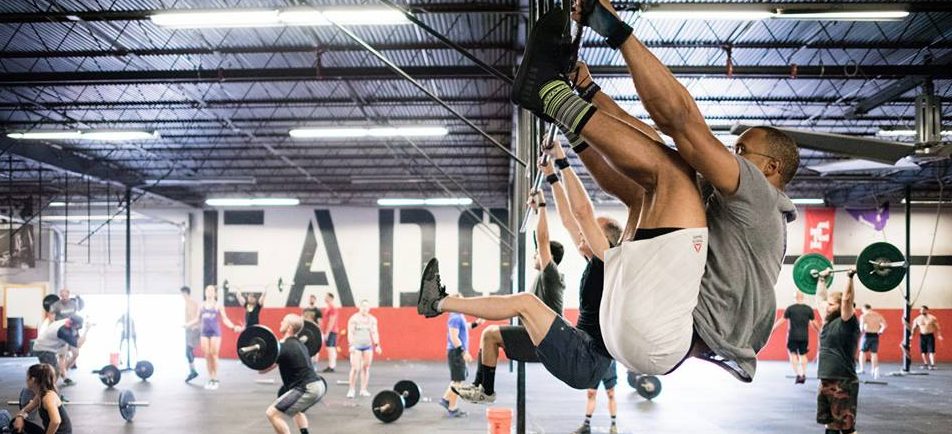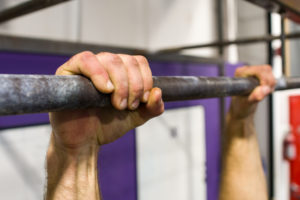Scaling the Toes to Bar

Scaling the Toes to Bar
by Matthew Sherburne
The Toes to Bar is one of the four most commonly tested gymnastics movements in our sport along with chest to bar pull ups, muscle ups and handstand push ups. Unlike the others, which primarily test the upper body, the toe to bar movement tests midline stability, strength, and muscle endurance. When done properly, toes to bar appear smooth and effortless. There are two purposes to this article; The first is to teach the progression towards an easy and efficient toes to bar and the second is to identify common faults that impede the ability to do big, easy, unbroken sets of toe to bar.
GRIP
Toe to bar starts with an athlete suspended from the pull up bar. Without a proper grip on the pull up bar, you’re setting yourself up for failure. There are two main features of your grip that we want to see: your thumb wrapped around the bar and pinky-finger knuckle on top of the bar.
Once your hands are properly gripping the bar, the next step is a tight grip. A tight grip will prevent the hands from rotating/moving on the bar, which is generally what forces the athlete to re-grip the pull up bar. Re-grip enough times = torn hands.
KNEE RAISE
Now that a strong grip has been established, the focus can shift to hip-flexion. When broken down to its most basic level, toes to bar are about closing down the hip joint. To reduce stress on the hip-flexors, the goal should be to bring the knees as high up into the chest as possible. With the legs extended, the hip flexors have to work exponentially harder create hip flexion. Most athletes should have little trouble setting their grip and bringing their knees into their chest while hanging from the bar.
SHOULDER KIP WITH KNEE RAISE
Muscle Ups, chest to bar pull ups and toes to bar all have one common component, a tight/strong shoulder kip and this is where things can go awry.
The purpose of the shoulder kip varies movement to movement. When performing toes to bar, the purpose is bring the athlete’s lower half of the body closer to the bar. The better the athlete can close the shoulder, and get further behind the bar, the less work they have to do to get their toes to the bar. Once a big powerful kip is established, adding a knee raise in concert with getting behind the bar is the next step.
Rhythm in this step of the toes to bar is crucial; without it, linking toes to bar will be inefficient and inconsistent. Most importantly, we do not want to see an athlete swinging wildly from the bar.
SHOULDER KIP WITH KNEE RAISE and KICK
The next step to the progression would be adding a kick towards the bar. Most athletes will start with a kick that ends with the toes being near the bar but not quite touching it. Upon kicking, the next step is to get the legs long and extended, which serves two purposes; It enables the athlete to get back into the front part of the kip again and it allows the athlete to regain tension in the shoulders and hips. The tension that is regained stretches the shoulder and hip joint therefore a strong contraction is possible a la “the stretch reflex”. One important note: if the athlete begins to lose rhythm, or they are unable to link reps together, the answers is always to work backwards one step aka the should kip with a knee raise. Rhythm is critical to have success in this movement.
TOES TO BAR
The last step is to complete the kick to the bar and then regain length in the lower body as you swing into your next rep
. Master this last step, your toe to bar efficiency and endurance will improve, thus making it possible for you to do more reps in bigger sets!
COMMON TOES TO BAR FAULTS
THE TRAINWRECK
The problem(s)
Safety: The balled up position the athlete has to get into to achieve the toe to bar is unsafe, especially with newer athletes, who might not know their limits yet. The grip slipping is common issue with toes to bar. If an athlete fell from the position, best case scenario they get the wind knocked out of them and at worst a spinal injury. For this reason we strongly advocate not letting athletes do toes to bar this way
Transferability: The “trainwreck” does not utilize the kip in a way that is transferable to other gymnastic movements (pull ups and muscle ups). When done properly, even without being able to get the toes to the bar, the kip that is seen in the scaled version of toes to bar helps develop that kip which is essential to other movements. Of course there are special occasions where you have to get your toes to the bar by any means necessary (the Open, other competitions, etc) but outside of those situations proper technique should be practiced.
THE PIKE
The problem
The Pike has half of the toes to bar perfect, the back swing. The long, extended leg position creates big, effortless back swing which allows the athlete to use the stretch reflex, which is free energy an athlete can harness. However, leaving the legs long and extended is not ideal on the way up to the bar. With the legs extended as the legs come up in front of the athlete, the lower abdominals and hip flexors have to work exponentially harder to the legs to the bar. Working harder for each rep means the athlete will not be able to repeat big sets of toes to bar, thus this style of toe to bar is inefficient.
THE SCOOP
The problem
Like the Pike, the Scoop has half of the toe to bar right, the opposite half. The scoop employs a knee up and kick to the bar, which is what we are looking for. However, the Scoop does not utilize any swing. Without harnessing the free energy that comes from getting the legs long and swinging, the hip flexors and lower abdominals have to work hard to redirect the legs from reaching down to the floor and back up to the bar. Again this style of toe to bar is inefficient, which is why we look to combine the Pike and the Scoop into one perfect combination for maximum efficiency.
At MisFit Athletics we are obsessed with movement and efficiency as it pertains to the sport of fitness. If you take the steps towards improving how you move in the toes to bar, while avoiding the common faults highlighted above, your efficiency will drastically improve. Have questions? Want to work on this with Interested in elevating your efficiency and subsequently your fitness? Come to a MisFit Camp near you: https://sharpentheaxeco.com/collections/events